Sending this toYeastspotting.
Click here for my blog index.

After weeks of driving, moving, and settling down, I've finally gotten my new kitchen more or less in order and ready to start baking/bloging again. Loving everything about Seattle so far, the active lifestyle, the urban living environment in downtown, the seafood, the "green" mentality -- I even like the grey weather! It's good for making laminated dough... :P
Now back to bread, this is a very Asian bread, I don't think I have seen anything similar in a western bakery. It's essentially the love child of Danish and Asian Style Soft Sandwich bread, inheriting the best qualities of both parties: nice and crispy on the outside, soft inside, and full of buttery goodness. While still a laminated dough, in order to rise high in the sandwich tin, it differes from croissants(tips here) and traditional danishs in following ways:
1. For croissants and danishs, we usually keep the dough fairly dry to ensure crisp and clean layers. While more kneading would make layers seperate more, resulting in a better crumb, we usually don't knead the dough to fully developement for the ease of rolling out. However, Asian style soft sandwich breads need to be kneaded very well to pass a very thin and strong windowpane test, otherwise the bread volume would suffer, and the texture won't be shreaddably soft (see details here). For this bread, we do knead the dough well (similar to other Asian style soft sandwich breads). In the mean time, the dough is kept pretty wet to have more extensibility, which make it possible to roll out.
2. Since the dough is fairly wet, and shaping procedure is different from traditional croissants, we don't expect as many honeycomb-like holes in the crumb, instead, crumb just need to be fairly even and open. In the mean time, the final dough doesn't need to be rolled out very thin (15mm instead of 4mm for croissants). For those reasons, the amount of roll-in butter is considerably less than croissants.
3. While for this particular batch in the first photo, I did one 4-fold, and two 3-folds, but this bread usually requires less folding than croissants. The most common method is one 4-fold, and one 3-fold, which I tried in another batch with good result.
In summary, since the dough requires less folds, and doesn't need to be rolled out very thin, it's an easier laminated dough than croissants and danishes. However, it does have different challenges: the intensive kneading to full developement, the final shaping which requires concise cutting and weighing, as well as braiding.
Laminated Sandwich Loaf (Adapted from many different sources)
Note: for details and tips on making croissants, please see this post
Note: for tips on kneading soft sandich loaves see this post
Note: this recipe makes about 930g of dough, less or more depending on how much you trim off the edges etc.
-levain
starter (100%), 44g
water, 75g
bread flour, 134g
1. mix and leave at room temp for 12 hours.
-final dough
bread flour, 361g
milk, 145g
egg, 77g
sugar, 60g
salt, 10g
instant yeast, 7g
butter, 41g, softened
levain, all
roll-in butter, 245g
1. Mix everything other than butter, knead until gluten starts to form. Add in butter, mix until fully developed. see this post for details. 
2. Round, press flat, put in fridge immediately for 2 hours.
3. Make butter block, put in fridge for at least one hour before using. Take out the dough, roll out, and enclose butter. (see this post for details)
4. Roll out to 20X60CM, fold one 4-fold as in the following pictures. Put in fridge for one hour
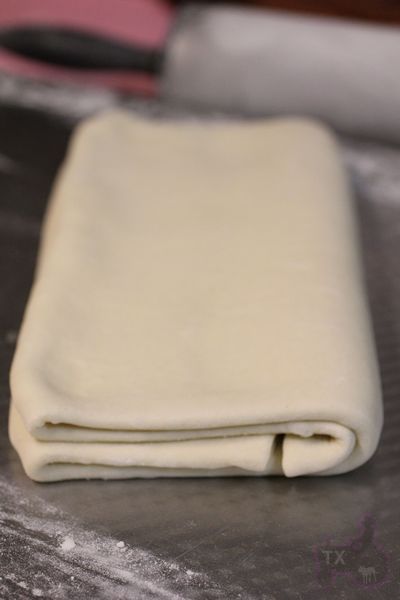
5. Roll out again and do one 3-fold, put in fridge for one hour. (see this post for details)
6. Repeat 5. (optional)
7. Roll out dough to 1.5CM-2CM thickness. Length of the dough piece would depend on the tin you use. Since we are braiding them, you will need the length to be about 2X length of the tin.
8. Cut the dough into thin pieces. This is where experience becomes important. We are braiding 3 pieces into one group, each group need to have a certain weight. Do note that if a tin requires more than one group of dough, each group should weigh the same, otherwise bread would appear uneven at the end. In another word, for each tin, select a weight for each dough group (less for flat top, more for round top), then stick to that weight for each group of dough.
a) For my bigger Chinese pullman tin (pictured on the left), I need 2 groups, each group has 3 pieces, and each group (all 3 pieces together) weigh 225-250g (225g if cover of the tin is used to make a flat top shape, more if cover is not used to make round top as in the picture).
b) For my small Chinese pullman tin, I only need one group of 3 pieces, each group (all 3 pieces together) weigh 150g (if cover of the tin is used to make top flat).
c) For 8X4 US loaf tin, I suggest to use 2 groups, each group has 3 pieces, and each group (all 3 pieces together) weigh 250-270g.
d) For KAF 13X4X4 pullman pan, I would suggest to use 4 groups, each group has 3 pieces, and each group (all 3 pieces together) weigh 195-215g.
9. For each group of 3 pieces of dough, braid them. Make sure the cut surface is facing up, to expose the layers. Fold ends under, put into tin. 
10. Proof at around 27C until 80-90% full, about 4-5 hours in my case. Egg wash if you are not using the pullman pan cover. 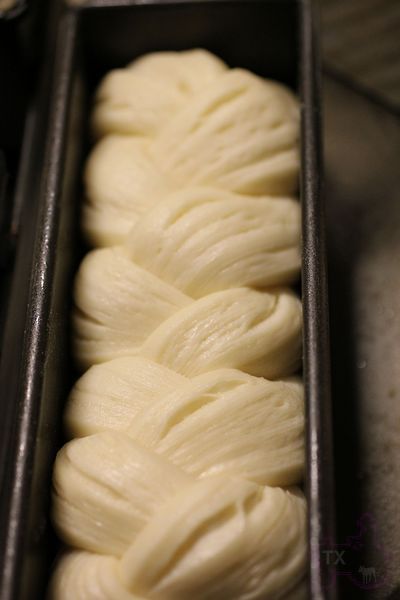
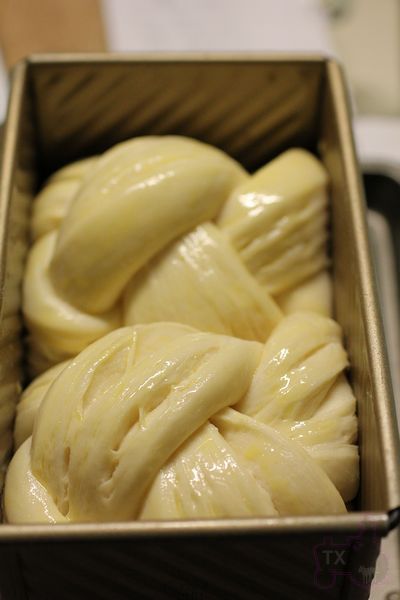
11: Bake at 425F for 10min, lowered to 375F and bake until done. The bigger Chinese tin which took 450g - 500g of dough, needed about 40-45min of TOTAL baking time. The smaller tin which took 150g of dough, needed 30min in total. If colors too much, cover with foil.
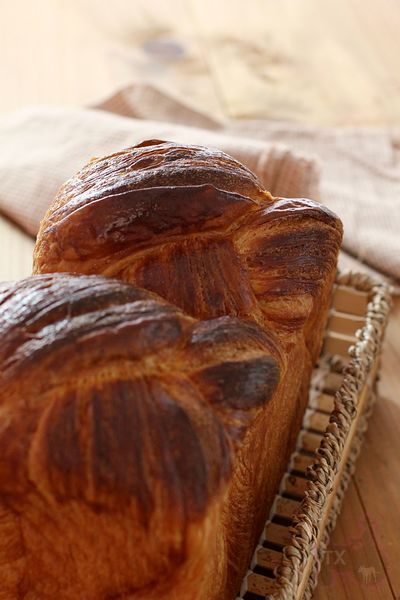
If the gluten network is fully developed, the bread should be proud and tall, with clear layers visible. 
If the pan cover is used, the dough amount needs to be fairly accurate for the pan, other wise it's each too short (not reaching the top), or bursting out (the cover can literally be blown open). This neat rectangle shape is nicknamed "golden sticks".
The crumb soft but open with honeycomb structor. 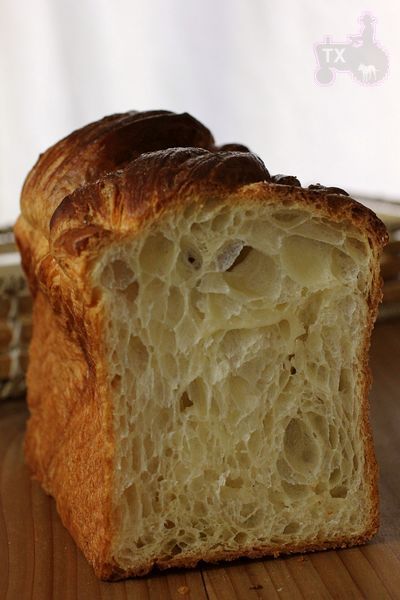
In general, I feel it's easier than croissants, since you can fold less and doesn't have to roll out as thin. However, the success does depend on proper kneading and careful piecing and shaping.
- txfarmer's Blog
- Log in or register to post comments
Beautiful bread.
I like the design very much; the pictures too.
How's the texture? Like a sandwich loaf of is it more brittle from the lamination?
The texture is crispy on the outside, and soft inside. And full of great buttery taste of course.
Brought over from Yeastspotting, only one photo.
B
Image
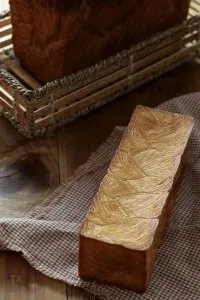
Xtx, all I can say is you have done another great post ;-)
Ron
Thanks Ron! I should just sign my post with xTx, Love it!
That is quite a stunning bread.
I am captured by the symmetry.
The crumb seems other-worldly for a sandwich loaf ... though I could see myself covered in jam falling through :)
Beautiful photos and compositions TX ...
All the best,
Phil
I agree, stunning indeed. May I feature it on the home page?
Sure Floydm! I am honored!
Thanks Phil. You are right the crumb is not jam friendly. :D
Txfarmer, those are two of the most beautiful loaves I've ever seen.
:^) from breadsong
Thanks, means a lot coming from you, breadsong!
Txfarmer,
this bread is extraordinarily beautiful. I've been admiring it as a esthetical object. And I can imagine how good it tastes.
Oh thanks! They taste great indeed, "too good", very dangerous.
super cool.
:) Thanks!
Txfarmer you have outdone yourself this time.! Can't wait to see what you come up with for your next post.
Thanks! I am still settling in and getting familar with my new city, new kitchen, and most importantly my new oven. My first batch of baguettes last weekend was a failure since I turned off the oven when I tried to turn off the timer, so when I was ready to load the baguettes, the oven was already half way cold. Ugh.
Awesome! Your loaf looks better than the "danish bread" they sell at the (popular) Bo-Lo'gne in Hong Kong and a darn sight tastier, I imagine!
This kind of bread is very popular in HK indeed, as well as all over China. Thanks fp!
That's very similar to the beautiful loaves that I saw in Okinawa. Except for the interior crumb of those breads was a little more dense - wonder if intensive kneading vs just reaching a good full development would make the difference? Or perhaps the way it is stacked in the pan? I was just beginning to poke my head up from the tremendous Winter Soltice marathon that I do and was thinking about working on laminating pain de mie, but you've beaten me to it.
Do you have source material other than your blogs? (In English - or with lots of pictures?)
Thanks...
Not sure about what's sold in Okinawa, but I do know the origins of Bo-lo'gne in HK lie in a bakery in Kyoto: http://blogs.wsj.com/chinarealtime/2010/04/16/whats-better-than-sliced-bread/
The Bo-lo'gne loaves tend to have the denser crumb you describe but the texture is light and fluffy (a la Hokkaido Milk Bread) whereas a similar loaf I tried from Salon de Thé de Joël Robuchon had a more open crumb but the texture is closer to croissants/danish. In addition to possible dough development issues, I wonder if differing ratios of dough to butter are a factor.
when I was rusticating in Okinawa, I posted some blog picture of the bread. It was sold at the department store near my hotel and had a much more random pattern on the crust. They also produced a thing that was shaped and slashed like a baguette that was definitely laminated and had a very open texture. My guess was that the square loaves were made from scraps from the "baguette" process, but I was unable to confirm this.
When I showed the pictures of this bread to "my teacher" there was an immediate response of "it must be laminated" which turned to "it's definitely not laminated" upon examination of the crumb. So much for the infallibility of our heros.
But that was my alternative thinking - that perhaps the "roll in" butter was reduced from the percentage that we would usually use for a laminated pastry.
I speculate on this not because these loaves aren't lovely, but because I do not personally enjoy the air like texture in bread. Chacun a son gout!
Here is a website that might interest you regarding the laminated breads. Let me know if it works for you.
http://ameblo.jp/v-vn-n/entry-10699955952.html
Ann
The crumb can be affected by many things. Even the ones sold from famous Asian bakeries around HongKong, Japan, and China display a range of "openness". Some possible reasons:
1) Flour. Some formulas use some cake flour along with bread flour to make the texture very soft. This of course reduces gluten strength, which makes crumb tighter.
2) Less roll-in butter.
3) Shaping. The flat top ones (including the one I made and the ones in the link yewshua provided above) have less room to expand, which also makes crumb less open.
4) Frankly, some of them just had butter leakage. :P
Unlike croissants, the standard for this kind of laminated loaf is not as "strict". Open or less open, as long as the layers are very clear on the outside, and the taste yummy, people still like them. I personaly like a more open crumb.
I don't have other source material since I developed this formula from many written and internet sources (mostly in Chinese) with few photos. For some reason, most of them don't even have a crumb shot.
from the poster above was mildly translateable and did show a crumb more like what I saw in Okinawa. They seem to imply that some butter leakage is desireable - but it must be controlled. Of course, I don't speak Japanese or Chinese and don't always comprehend the idioms inherent in the translations.
The more open crumb is, of course, a matter of taste - as is the taste (and texture) of these oriental breads. I've had this discussion over and over, but to my decidedly Western palate so many of these beautiful breads don't really have much taste to them. I put this down to cultural differences as these bakers in Japan are very skilled and should they want a more aggressive taste they certainly could achieve it.
I've also gone many rounds on "intensive mix" with "my teacher" (and have the mental bruises to show for it) and am still trying to reconcile those views with your results. However, do note my realizations on the infallibility of our heros...
It is a lovely bread and confirms my first suspicions of how to get that bread I remember from Okinawa. It was making its way to my 2012 baking plan and you've given me a great head start. Thanks.
to my decidedly Western palate so many of these beautiful breads don't really have much taste to them
It's so interesting to hear you say that. I bake a lot of "European Style" hearth breads with simple ingredients, S&F with minial mixing to preserve flavor, long rise etc. However, a lot of my Chinese friends describle these breads to "not have much taste". :D I think you mean different kinds of "taste" in this case. For a lot of Asian customers, they are looking for a strong flavor not from flour itself, but other ingredients in the dough such as sugar, butter, etc. Breads serve as desserts or snacks at most, not main meals. While in US and Europe, breads are the main component of a meal, subtle flavor of flour is more appreciated.
An analogy would be "rice". In China (and other Asian countries), we most often eat plain steamed rice and much attention is paid to the quality of the rice itself. While in weatern countries, "fried rice" or other rice "dishes" with lots of complement ingredients are more popular.
Different taset indeed!
Cultural indeed. Rice is such a complex topic in and of itself. I was always taught that rice should be fuffy and each grain separate - then I had the experience of sticky rice for breakfast each morning. Eaten unadorned it is just perfect. The long grain rice commonly found in US grocery stores - not so much.
The reaction to your breads is another fascinating data point.
I think about these things from time to time.
and perfectly satisfied to just stare at them, forever, and ever. Even raw. Wow! ( I have to remind myself to breathe.)
Now trying to imagine the light crispy crunch of the crust upon biting. .... Oh My Gd! :)
Ha mini, I like the look of proofed loaves right before baking too. Such clear layers.
Glad to see you made it in one piece. I am envious of anyone who lives even close to the Pike Street Market. Seattle is a wonderful place, I'm certain you and your husband will enjoy it.
Beautiful concept in this bread. I'll bet it would make a good base for a sandwich if the first layer was lettuce or sliced meat. I imagine the flavor to be similar to a croissant, so chocolate chips scattered in the braid might be interesting. Lol.
Eric
Hey Eric. Yes, I am indeed very close to Pike St Market, about 20min of walking, 10min of bus. There are so much around downtown near my apartment that I haven't really been to Pike much though. So many boutique individual specialty vendors, a lot of them organic, are here in Seattle, as supposed to big chain stores in DFW. I love it!
I was reading along, enjoying the writing and the photos as I always do when you post something, and when I got to the first picture of the open crumb I actually gasped. I was so surprised and amazed! This is truly a stunning and impressive work of the baker's art. I'm looking forward to your posts from Seattle, a very special place. I baked a 36-hour baguette from your formula on Sunday, by the way, and it was quite a hit in my house! Wonderful bread.
-Janie
Thanks, and I am so glad that you liked the baguettes. The 36 hour baguette is a house favorite, I make those at least once a week.
I was doing the baker's percents on your formula and just had to ask for your rationale for using a firm pre ferment. One would assume that such a pre ferment - especially with natural leaven would bring a strengthening effect to the dough rather than adding extensibility. So, obviously you have a reason in mind and it would be interesting to understand...
Thanks.
Good question.
Short answer: firm leaven does increase strength, which is exactly what I want.
Long answer.
1. As my rambling poolish croissant post mentioned, while most laminated dough recipes want the dough to be relatively weak for the ease of rolling out, a strong dough in fact makes a better croissant/danish/etc. The reson is simple, a strong dough rises more, which makes the crumb more open, and the honeycomb structure more visible. In another word, strong dough gives better results, but harder to handle and easier to screw up. For that reason, I use bread flour, firm leaven, and quite a bit of kneading when I make croissants. However, I shy away from knead the dough 100% fully because I am only human, who's without a sheeter, I can't roll out too strong of a dough.
2. For Asian Style sandwich breads, strong dough also gives better results: higher profile, bouncier texture etc. That's why I always knead my dough fully when I make those kinds of breads.
3. Since this laminated sandwich bread is a hybrid of 1 & 2, a strong dough is also preferable.
Now, how do we deal with the lack of extensibility?
1. A sheeter, which I don't have
2. A wetter dough. That's usually not an option for traditional croissants and danishes since too wet of a dough usually softens the crumb and make the honeycomb structor less defined. However, it IS indeed a good option for both Asian style sandwich breads and this particular laminated sandwich loaf, because we don't expect the crumb to be very clearly hole-y.
3. Lots of resting periods between rolling out to relax the dough. I have at least one hour between folds/rolling out for that particular reason.
Does that sort of answer your question? Can you tell I am an engineer? :P
always glad to interact with a fellow engineer. What you say makes sense in the context of what you are looking for in the bread.
It also makes sense in the context of what I experienced with my last batch of challah. After many successful batches, I suddenly go exploding challah (and yes, it was fully proofed before baking) - turns out that for reasons unknown (delirium, sheer cussedness, desire to show how I can reformulate on the fly - I really don't know why) I had used a firm levain pre ferment instead of my usual liquid pre ferment. Made a minor differences throughout the process, but had a huge effect (and not a good one for some shapes) on oven spring.
Yes, this gives me another factor to consider. Thanks.
You are right in that, how we handle each aspects of bread making completely depends on what we are looking for in a bread - and that might/would be very different in different kinds of bread. If Asian Sandwich Loaves/croissants are one extreme where I want a stronger dough through intensive kneading, the other extreme might be baguettes. For baguettes, I tend to use liquid leaven, and only S&F with minimal kneading -- in order to get extensibility and natural flavor of the flour. Country hearth breads are probably closer baguette, but should have a tad more strength. Breads like challah would indeed be somewhere in the middle -- I usually do knead the dough, but not fully developed. I have used firm leaven for challah breads and loved the taste, but I adjusted my kneading/proofing time to avoid over-expansion in the oven.
Stunning breads txfarmer....they look far too beautiful to eat...
Glad to read about you settling into your new home. I imagine the cool weather and all of the lush greenery that abounds in Seattle is a welcome respite from the summer you just had back in Texas...
A question about firm vs liquid leaven with challah breads....I am about to embark on my first sourdough challah and I usually work with firm leavens for my usual sandwich and hearth breads but after reading Pat's comment on her challah and yours I realize I need a bit more information/educating before embarking on that project.
In you final sentence you state that you adjusted your kneading and proofing times when you used a firm leaven. Am I correct in assuming that you didn't knead quite as long and that you proofed longer than you would have had you used a liquid leaven?
Take Care,
Janet
Thanks Janet! Yes, I kneaded less and proofed longer.
And because I don't know what exactly I was thinking when I mixed up and used the firm levain, I did not adjust my mix time - with the predictable results. I'm also getting the hang of the new mixer - for awhile I was being too timid with mix times. I can judge the degree of development of the dough pretty well, but you know how it goes - the timer says one thing, your senses say another and you start to wallow in self doubt. So now, I think I'm over compensating - or at least I did on that batch of challah! Tasted good, though.
Actually, if Iwere to compare the two different challah making experiences end to end, I would prefer the liquid pre ferment. Which is what makes the world go around - different styles and different ways to achieve them...
Although I have no intent of baking a bread like this, I am gobsmacked by what you have achieved with these loaves, txfarmer. They are visually stunning.
Paul
That's the word I was looking for. We need Roald Dahl to find the words to describe this bread. -Varda
Gobsmacked. Love this word! :D
Beautiful on the inside as well as the outside! The pictures really show how you've taken care with each stage of the process. You are an artist.
Thanks mwilson!
I didn't know you lived in Taiwan before! They have a lot of Japanese influences when it comes to food, I am not surprised that this bread is common there. Thanks!
Pure , Art, Txfarmer! your work belongs in museums or featured on hardcovers of fancy books.
Love your perseverance.
You are too kind Mebake, thanks!
Excellent! Excellent! Congratulations!
http://szanter.blogspot.com/
I am intrigued by Asian breads.. this is a new style that I hadn't encountered before. Anxious to try it myself. I have a friend that gave me a recipe for a "custard" bread, which I've made several times. http://www.thefreshloaf.com/node/20081/super-soft-custard-bread-images Without the traditional Asian loaf pan, it's hard to get it just right, but I do just fine with a regular bread pan.
Seattle is my home town - I no longer live there, but I know it fairly well. Make sure the next time you are walking to Pike Place, stop by the Crumpet Shop and enjoy their freshly made crumpets with a bit of tea. They are, a real treat.
Belles
Not only is this bread stunning, I, for one, love the open crumb on your bread. I love the holes that hold melted butter with jam. It adds a much richer layer of flavor than the closed crumb does. So I think it is grand.
I have a favor to ask please, if you don't mind? Could you also post how long you kneaded the bread, and if with a mixer, type of mixer (Kitchenaid 300) and on what setting (2, 3, 4) please?
I have a great deal of trouble getting my dough to a windowpane point as I'm concerned I am kneading it too much.
Thank you and well done!
OMFG this one left my mouth watering. Thanks for so much inspiration on laminated doughs, master!!
Big wow.
Thank you for the detailed explanations.
am sorry for this question.. since i am total newbie to bread baking.. was wondering how does one make/buy Starter (as mentioned in your ingredients).
Hi - sorry I'm about 9 years late to the blog. But, would you kindly update the pictures? For some reason, I can see blurred versions of it.
Thanks so much!
misheil